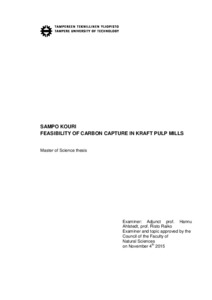Feasibility of Carbon Capture in Kraft Pulp Mills
Kouri, Sampo Elias (2016)
Kouri, Sampo Elias
2016
Ympäristö- ja energiatekniikan koulutusohjelma
Luonnontieteiden tiedekunta - Faculty of Natural Sciences
This publication is copyrighted. You may download, display and print it for Your own personal use. Commercial use is prohibited.
Hyväksymispäivämäärä
2016-03-09
Julkaisun pysyvä osoite on
https://urn.fi/URN:NBN:fi:tty-201602243559
https://urn.fi/URN:NBN:fi:tty-201602243559
Tiivistelmä
The purpose of this thesis was to assess the feasibility of carbon capture in Finnish Kraft pulp mills. The feasibilities of thirteen different technology options were evaluated based on their technical maturity, capture potential and estimated break-even price for emission allowance including biogenic emissions. Also the role of pulp and paper industry in climate change mitigation was discussed.
The study was conducted by comparing oxy-fuel combustion cases modelled with Balas software and a fuel switch option calculated based on mass and energy balances with results from previous studies. The technical maturity was evaluated based on previous studies and existing commercial activity. The break-even prices from literature were recalculated under the same assumptions for investment costs, commodity costs and supporting policies. Two price estimates were calculated: one including supporting policies and possibly available revenue and another excluding them. The capture potential was estimated using a reference mill scaled to the pulp production rate of 1200 ADt/d. Part of the technologies require large structural changes and were considered available only if the mill is rebuilt. Thus the capture potential in the reference mill was scaled up based on either the capture potential in mills to be rebuilt by 2030 or the capture potential in all Finnish pulp mills. The relevant capture potential was calculated based on the production capacities and the estimated age distribution of the chemical recovery sections in Finnish pulp mills. The results from this thesis were subjected to qualitative and numerical sensitivity analyses.
Carbon capture in pulp mills seems feasible only if other revenues than CCS supporting policies are available. These revenues could include by-products like biofuels, higher energy efficiency or increased pulp production. The cases of lignin separation and black liquor gasification to transportation fuels were most cost efficient, but the capture potentials were limited to 1.45 Mt(CO2)/a and 0.82 Mt(CO2)/a, respectively. Small scale carbon capture for utilization could be achieved with pre-calcination, as the break-even price was only around 4.5-7.3 €/t(CO2). Large scale implementation of carbon capture in the Finnish pulp mills with monoethanolamine (MEA) absorption had a capture potential of up to 12 Mt(CO2)/a, but the break-even price was around 70-80 €/t(CO2) excluding transportation and storage costs. Moreover, barriers in transportation and storage and in the lack of incentives for bio-CCS remain. In addition to CCS, the pulp and paper industry could mitigate the climate change by increasing the amount of carbon based products, sustainable forestry practices and investments in forestation.
The study was conducted by comparing oxy-fuel combustion cases modelled with Balas software and a fuel switch option calculated based on mass and energy balances with results from previous studies. The technical maturity was evaluated based on previous studies and existing commercial activity. The break-even prices from literature were recalculated under the same assumptions for investment costs, commodity costs and supporting policies. Two price estimates were calculated: one including supporting policies and possibly available revenue and another excluding them. The capture potential was estimated using a reference mill scaled to the pulp production rate of 1200 ADt/d. Part of the technologies require large structural changes and were considered available only if the mill is rebuilt. Thus the capture potential in the reference mill was scaled up based on either the capture potential in mills to be rebuilt by 2030 or the capture potential in all Finnish pulp mills. The relevant capture potential was calculated based on the production capacities and the estimated age distribution of the chemical recovery sections in Finnish pulp mills. The results from this thesis were subjected to qualitative and numerical sensitivity analyses.
Carbon capture in pulp mills seems feasible only if other revenues than CCS supporting policies are available. These revenues could include by-products like biofuels, higher energy efficiency or increased pulp production. The cases of lignin separation and black liquor gasification to transportation fuels were most cost efficient, but the capture potentials were limited to 1.45 Mt(CO2)/a and 0.82 Mt(CO2)/a, respectively. Small scale carbon capture for utilization could be achieved with pre-calcination, as the break-even price was only around 4.5-7.3 €/t(CO2). Large scale implementation of carbon capture in the Finnish pulp mills with monoethanolamine (MEA) absorption had a capture potential of up to 12 Mt(CO2)/a, but the break-even price was around 70-80 €/t(CO2) excluding transportation and storage costs. Moreover, barriers in transportation and storage and in the lack of incentives for bio-CCS remain. In addition to CCS, the pulp and paper industry could mitigate the climate change by increasing the amount of carbon based products, sustainable forestry practices and investments in forestation.
